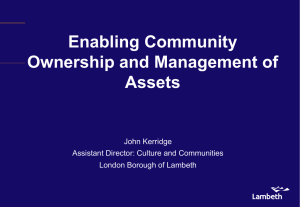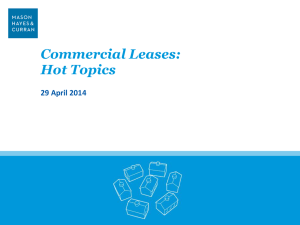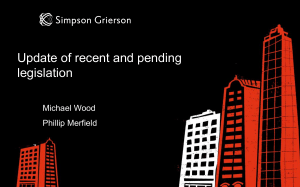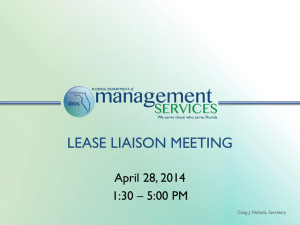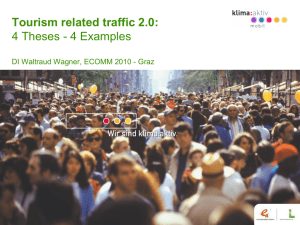Winners and Pitfalls Leasing Issues 2014
advertisement
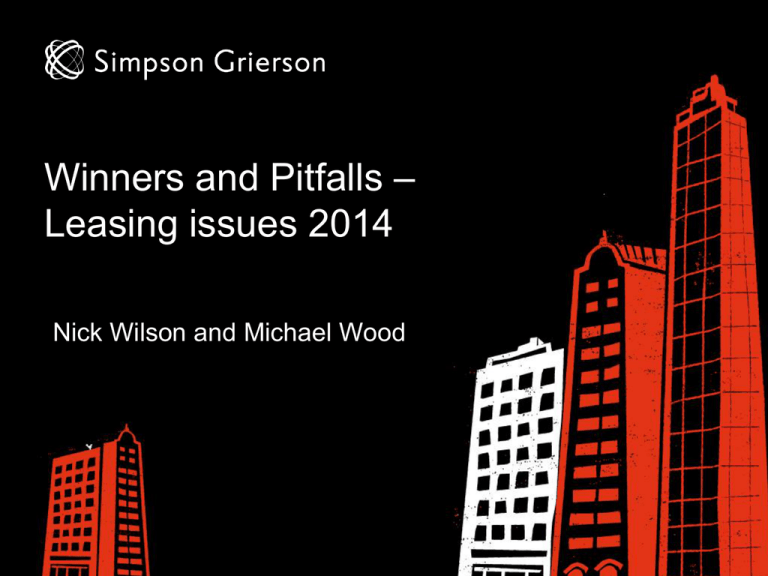
www.simpsongrierson.com Winners and Pitfalls – Leasing issues 2014 Nick Wilson and Michael Wood What we will cover today www.simpsongrierson.com Current issues applying to leasing including: • Contamination and Remediation • Earthquake Strengthening and Seismic Rating • Insurance • Any other topics or matters keeping you up all night… www.simpsongrierson.com Contamination and Remediation www.simpsongrierson.com Auckland Waterfront Development Agency Ltd v Mobil Oil New Zealand Ltd AWDAL v Mobil www.simpsongrierson.com • Commercial lease at Auckland’s waterfront tank farm • Used for oil storage facilities • First leases to oil companies 1920 • 1920s-30s other Exxon Mobil Group entities lease sites • Mobil’s first leases 1950s-60s • Expired and new leases in 80s – short term periodic. Termination rights. These expired in 1994. • AWDA attempted to negotiate new terms with specific decontamination requirement – Mobil refused and held over until 2011 AWDAL v Mobil www.simpsongrierson.com Tenant’s Obligation (under most recent (1985) lease): • During lease: To keep the land “in good order and clean and free from rubbish and weeds and growth; and • Upon expiry: to deliver up the land “in such good and tenantable repair and condition and clean and tidy to the reasonable satisfaction of the lessor” • Issue: Does this clause require the Tenant to decontaminate? AWDAL v Mobil www.simpsongrierson.com AWDAL v Mobil www.simpsongrierson.com Court to decide what did the parties intend in agreeing the “Clean and tidy” clause? 1. Natural and ordinary meaning of clause AWDA: must be returned in an “undamaged state” so any contamination must be removed Mobil: no obligation to rid land of all historic subsurface contamination. Surface appearance only. Court: natural and ordinary meaning not so apparent - need to look at broader context to determine meaning of clause AWDAL v Mobil www.simpsongrierson.com 2. Pre-contract negotiations “admissable to establish the parties’ knowledge of relevant circumstances, providing the setting in which they used the relevant words in the contract, including the genesis of the transaction, the background, the context, the market in which they are operating, and the subject matter” AWDAL v Mobil www.simpsongrierson.com 3. Post Contract conduct “If the Court can be confident from their subsequent conduct what both parties intended their words to mean and the words are capable of bearing that meaning, it would be inappropriate to presume that they meant something else” Gibbons Holdings Ltd v Wholesale Distributors Ltd [2007] www.simpsongrierson.com 4. Other relevant facts The Court noted: (a) Much of contamination had already occurred at the time of Mobil’s original lease – unusual for a tenant to agree to be responsible for remedying damage caused by another (b) Original leases – no obligation to decontaminate – to change this policy, it would expect it to be clear and unambiguously expressed (c) 1980s leases were short term – shorter the term, the less likely an onerous and expensive repair obligation would have been intended AWDAL v Mobil www.simpsongrierson.com 5. Doctrine of “waste” - the temporary use of the land did not (without the consent of the lessor) entitle a tenant to damage or alter the lessor’s interest in the land 6. Obligation to “keep” the land clean and tidy - infers obligation to make sure that the land is clean and tidy on commencement and if necessary to make it so - the fact an earlier tenant allowed the premises to fall into disrepair is irrelevant AWDAL v Mobil www.simpsongrierson.com 7. Mobil’s (and other Exxon Mobil entities) long term occupancy 8. Anstruther authorities Rule: covenant to repair should be construed with reference to the age, character and locality of the premises (at commencement) 9. Implied term requiring steps to prevent contamination and remove hydrocarbons AWDAL v Mobil www.simpsongrierson.com • Mobil wins. AWDA’s claim fails in entirety and costs awarded against it. • Lessons: - Be clear and unequivocal - Be mindful of make good at lease renewal/redocumentation but - Difficult to imply meaning to clause signed some time ago worth a try… - Don’t remain silent on key points – mutual conduct can be relevant to intention of the parties - Your conduct/actions can prejudice/benefit your position www.simpsongrierson.com EARTHQUAKE PRONE BUILDINGS – LEASE IMPLICATIONS Earthquake Prone Buildings and implications to leasing • What is the regime now? • The new Bill • Risks for Landlords and Tenants www.simpsongrierson.com Earthquake Prone Buildings • Building Act 2004 • Definition of Earthquake Prone Building www.simpsongrierson.com Earthquake Prone Buildings www.simpsongrierson.com • Territorial Authority policies Policies generally set out that a TA: – will check the accuracy of its legacy files by a field search; – will initially assess pre-1976 buildings within a certain timeframe. This may be graduated based on various risk factors (within 1 to 30 years, 2.6 year average); – may require further and detailed assessments of pre-1976 buildings (within 1 to 25 years, 2.5 year average); – TAs will discuss the strengthening or demolition options if your building is earthquake prone; – TAs will issue a section 124 notice once a building is found to be earthquake-prone (1 to 70 years, 17 year average); and In all cases, timeframes are graduated on various risk factors What are territorial authorities’ current powers and obligations in relation to earthquake-prone buildings? www.simpsongrierson.com • TA earthquake-prone building policies are not directly enforceable • Rather, policies are statements of how a TA will behave in relation to earthquake-prone buildings • A TA can’t use a policy to require strengthening beyond 34% of NBS (Insurance Council of New Zealand v Christchurch City Council [2013] NZHC 51) What are territorial authorities’ current powers and obligations in relation to earthquake-prone buildings? www.simpsongrierson.com • If a TA considers a building to be earthquake-prone, it may use its powers under section 124 BA to: – put up a hoarding or fence to prevent people from approaching the building nearer than is safe (subsection (1)(a)); – attach a prominent notice warning people not to approach the building (subsection (1)(b)); and – importantly, require work to be carried out on the building to “reduce or remove the danger”. Strengthening above 34% of NBS could be required if that is the only practicable method of strengthening your building (subsection (1)(c)) • Prohibition on use or occupation of building where s124 notice (s128 BA) • TAs may also use alternative powers under sections 112 and 115 Case law www.simpsongrierson.com • Judicial review: The Insurance Council of NZ Incorporated v CCC & Ors – TA’s may not use section 124 notices to require building works to exceed level above 34% of NBS • Lambton Quay Properties Nominee Ltd v Wellington City Council – Dealt with issue of demolition of EPB which was a historic building – Court should consider: – Is there any reasonable alternative to total demolition? – Risk to public safety and surrounding buildings if building remains as is – Tension between RMA and BA Building (Earthquake-prone Buildings) Amendment Bill • Royal Commission and MBIE Proposals • Currently at Select Committee (subject to change) – EPBs remain < 34% NBS – No more individual TA policies – 5 years for all EPB’s to be identified – consistent national methodology www.simpsongrierson.com Building (Earthquake-prone Buildings) Amendment Bill - contd www.simpsongrierson.com – Register of information on seismic capacity of buildings – Another 15 years to carry out strengthening work or have buildings demolished (unless priority building (earlier) or Category 1 Heritage Building (later – up to 25 years)) – Priority buildings to be defined in Regs but include buildings that could collapse and impede transport route or those which are significant to public safety Building (Earthquake-prone Buildings) Amendment Bill www.simpsongrierson.com – Exemptions can be applied for if meet criteria in Regs – Specific seismic work notice section - removed from s124 which also deals with dangerous, affected and insanitary buildings 31 March 2015 for Select Committee Report – watch this space Risk for landlord and tenants • Due diligence • Seismic warranties/premises condition report • Value • Costs • Access for strengthening/option to terminate www.simpsongrierson.com Risk for landlord and tenants contd • Insurance • Tenantability • Improvement rent • Health and safety www.simpsongrierson.com www.simpsongrierson.com Insurance obligations under Leases Insurance obligations under Leases www.simpsongrierson.com • General Position – tenant to repair to the state as at commencement • Weight of liability with the tenant • Conflicting case law Marlborough Properties Ltd v Marlborough Fibreglass Ltd Leisure Centre Limited v Babytown Ltd Insurance obligations under Leases www.simpsongrierson.com • This conflict is addressed by: (a) the landlord insuring and indemnifying the tenant for the costs of reinstatement works (approach under ADLS lease); or (b) joint insurance policy (not common) Insurance obligations under Leases • Pre and post 1 January 2008 Leases • Property Law Act 2007 – s269-271 www.simpsongrierson.com Exoneration of Lessee – s269 PLA www.simpsongrierson.com Rights of Lessor if Lessee negligent www.simpsongrierson.com Insurance obligations under Leases www.simpsongrierson.com • Sheehan v Watson - Protection applies to Lessee’s agents (employees) as well • Court imposed a purposive approach though section dealing with indemnity does not refer to Lessee’s agent • While meaning of text of statute appears plain when read in isolation, it needs to be cross checked against purpose • Consequential losses - Galbraith - there is no reason to distinguish between insurance for physical damage and insurance for business loss Insurance obligations under Leases www.simpsongrierson.com • Joint ownership of policy - One Three Four Ltd v J R F Holdings Ltd - Benefit to tenant to jointly insure - consider if the tenant is to receive part of insurance proceeds how the shortfall to rebuild will be funded You can contract out… www.simpsongrierson.com • Contracting out (s271) – express acknowledgement that landlord has not insured or fully insured and can agree that the tenant will meet the cost of making good destruction/damage Questions and discussion www.simpsongrierson.com



